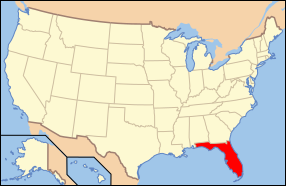Florida in the American Civil War
| State of Florida | |||||
|---|---|---|---|---|---|
| Nickname(s): None | |||||
|
|||||
| Capital | Tallahassee | ||||
| Largest City | Jacksonville | ||||
| Admission to confederacy | February 4, 1861 (3rd) | ||||
| Population |
|
||||
| Forces supplied |
|
||||
| Major garrisons/armories | Fort Pickens | ||||
| Governor |
Madison Perry (1861) John Milton (1861–1865) Abraham Allison (1865) |
||||
| Senators |
Augustus Maxwell James Baker |
||||
| Representatives | List | ||||
| Restored to the Union | June 25, 1868 | ||||
Florida joined the Confederate States of America at the beginning of the Civil War, as third of the original seven states to secede from the Union, following Lincoln's 1860 election. With the smallest population, nearly half of them slaves, Florida could only send 15,000 troops to the Confederate States Army. Its chief importance was in food-supply to the south, and support for blockade-runners, with its long coastline full of inlets, hard to patrol.
On the outbreak of war, the Confederates seized many of the state's army camps, though the Union retained control of the main seaports. But there was little fighting in Florida, the only major conflict being the Battle of Olustee near Lake City in February 1864. However, wartime conditions made it easier for slaves to escape, and many of them became useful informers to Union commanders. As southern morale suffered, deserters from both sides took refuge in Florida, often attacking Confederate units and looting farms. Tallahassee became the second-last Confederate state capital to fall to the Union army. In May 1865, Federal control was re-established, slavery abolished, and the state governor John Milton shot himself, rather than submit to Union occupation.
Secession was declared January 10, 1861, and, after less than a month, Florida became one of the founding members of the Confederacy. The first six states to secede had the largest population of slaves among the Southern states. Although the vote to secede passed 62-7, there was a pro-Union and anti-Confederate minority in the state, an element that grew as the war progressed.
Florida sent a three-man delegation to the 1861-62 Provisional Confederate Congress, which first met in Montgomery, Alabama, and then in the new capital of Richmond, Virginia. The delegation consisted of Jackson Morton, James Byeram Owens, and James Patton Anderson, who resigned April 8, 1861, and was replaced by George Taliaferro Ward. Ward served from May 1861 until February 1862, when he resigned and was replaced by John Pease Sanderson.
...
Wikipedia



